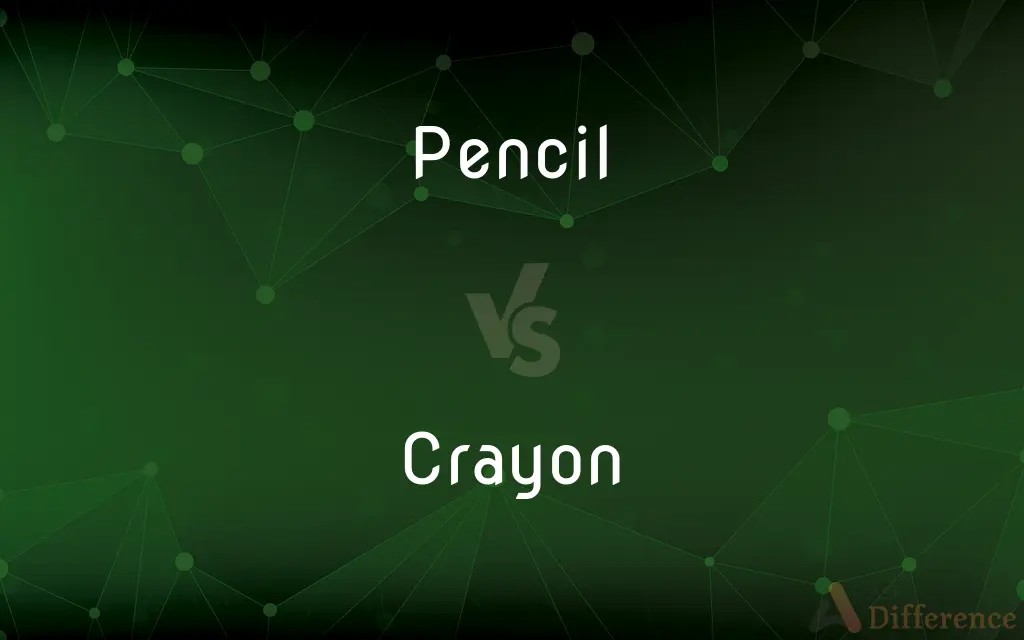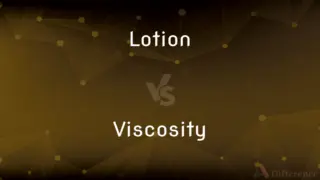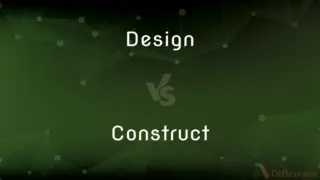Pencil vs. Crayon — What's the Difference?
By Tayyaba Rehman & Urooj Arif — Updated on March 11, 2024
Pencils, made of graphite encased in wood, are known for precise writing and sketching, whereas crayons, wax-based sticks with color pigments, are favored for their vibrant hues in art.

Difference Between Pencil and Crayon
Table of Contents
ADVERTISEMENT
Key Differences
Pencils, typically made from graphite encased in wood or mechanical casings, offer fine lines and varying shades of gray for detailed sketching and writing. They allow for precision and can easily be erased, making them ideal for drafting and academic work. Whereas crayons, composed of wax and colored pigments, provide a range of vivid colors suitable for broad, expressive strokes. They are often used by children for coloring due to their durability and ease of use.
While pencils can be sharpened to maintain a fine point for detailed work, crayons wear down to a blunt edge, which can limit detail but encourage broader, textured applications. This characteristic makes crayons less suitable for precise work but excellent for filling large areas with color.
Pencils come in various hardness levels, indicated by a scale from 9H (hardest) to 9B (softest), affecting the darkness of the marks they make. This allows artists and writers to choose a pencil that matches their needs for shading and line work. Crayons, on the other hand, do not offer such variations in hardness but come in a wide array of colors, enabling vibrant and diverse artistic expressions.
The materials used in pencils and crayons also contribute to their distinct uses. Pencil marks can be easily erased from paper, allowing for corrections and adjustments. Crayon marks, being wax-based, are more resistant to erasing, which can foster a sense of permanence and boldness in artwork.
Regarding portability, both pencils and crayons are easily transported and do not require additional tools for basic use. However, pencils may require a sharpener or mechanical pencil leads for continued precision, while crayons may become messy or melt in high temperatures, affecting their convenience.
ADVERTISEMENT
Comparison Chart
Composition
Graphite encased in wood or mechanical
Wax with color pigments
Use
Writing, sketching, precise work
Coloring, broad strokes, art
Variability
Hardness levels (9H to 9B)
Wide range of colors
Erasability
Easily erased
Resistant to erasing
Maintenance
Requires sharpening
Wears down, may become messy
Compare with Definitions
Pencil
Can be sharpened to maintain a fine point for detailed work.
The artist sharpened his pencil before starting the intricate drawing.
Crayon
Wears down to a blunt edge, limiting detail but good for broad strokes.
Using a blunt crayon, she colored the sky blue.
Pencil
Requires a sharpener or mechanical leads for continuous use.
She replaced the lead in her mechanical pencil to continue writing.
Crayon
Can become messy or melt in high temperatures.
The crayons melted in the sun, blending the colors together.
Pencil
Marks made can be easily erased, allowing for corrections.
After noticing a mistake, he quickly erased the pencil mark.
Crayon
Resistant to erasing, fostering boldness in artwork.
The crayon drawing remained vibrant even after attempting to erase it.
Pencil
Comes in various hardness levels for different shading and line work.
For softer shadows, she switched to a 2B pencil.
Crayon
Offers a range of vivid colors suitable for expressive artwork.
He chose a red crayon to draw the sunset.
Pencil
A tool for writing or drawing, consisting of a thin stick of graphite encased in wood or a mechanical holder.
She used a pencil to sketch the landscape.
Crayon
A stick of colored wax used for drawing or coloring.
The child filled the page with bright crayon colors.
Pencil
A pencil is an implement for writing or drawing, constructed of a narrow, solid pigment core in a protective casing that prevents the core from being broken or marking the user's hand. Pencils create marks by physical abrasion, leaving a trail of solid core material that adheres to a sheet of paper or other surface.
Crayon
A crayon (or wax pastel) is a stick of pigmented wax used for writing or drawing. Wax crayons differ from pastels, in which the pigment is mixed with a dry binder such as gum arabic, and from oil pastels, where the binder is a mixture of wax and oil.
Pencil
A narrow, generally cylindrical implement for writing, drawing, or marking, consisting of a thin rod of graphite, colored wax, or similar substance encased in wood or held in a mechanical holder.
Crayon
A stick of colored wax, charcoal, or chalk, used for drawing.
Pencil
Something shaped or used like a pencil, especially a narrow medicated or cosmetic stick
An eyebrow pencil.
Crayon
A drawing made with one of these sticks.
Pencil
A style or technique in drawing or delineating.
Crayon
To draw, color, or decorate with a stick of colored wax, charcoal, or chalk.
Pencil
Descriptive skill
"His characters are drawn with a strong pencil" (Henry Hallam).
Crayon
A stick of colored chalk or wax used for drawing.
Pencil
An artist's brush, especially a fine one.
Crayon
A colored pencil, a colouring pencil
Pencil
(Physics) A beam of radiant energy in the form of a narrow cone or cylinder.
Crayon
(dated) A crayon drawing, or a drawing with colored lines.
Pencil
(Mathematics) A family of geometric objects, such as lines, that have a common property, such as passage through a given line in a given plane.
Crayon
(dated) A pencil of carbon used in producing electric light.
Pencil
To write or produce by using a pencil.
Crayon
(ambitransitive) To draw with a crayon.
Pencil
To mark or color with or as if with a pencil.
Crayon
An implement for drawing, made of clay and plumbago, or of some preparation of chalk, usually sold in small prisms or cylinders.
Let no day pass over you . . . without giving some strokes of the pencil or the crayon.
Pencil
A paintbrush.
Crayon
A crayon drawing.
Pencil
A writing utensil with a graphite (commonly referred to as lead) shaft, usually blended with clay, clad in wood, and sharpened to a taper.
Crayon
A pencil of carbon used in producing electric light.
Pencil
(optics) An aggregate or collection of rays of light, especially when diverging from, or converging to, a point.
Crayon
To sketch, as with a crayon; to sketch or plan.
He soon afterwards composed that discourse, conformably to the plan which he had crayoned out.
Pencil
(geometry) A family of geometric objects with a common property, such as the set of lines that pass through a given point in a projective plane.
Crayon
Writing implement consisting of a colored stick of composition wax used for writing and drawing
Pencil
A small medicated bougie.
Crayon
Write, draw, or trace with a crayon
Pencil
(gambling) power of the pencil
Pencil
(transitive) To write (something) using a pencil.
I penciled (BrE: pencilled) a brief reminder in my notebook.
Pencil
(transitive) To mark with, or as if with, a pencil.
Pencil
A small, fine brush of hair or bristles used by painters for laying on colors.
With subtile pencil depainted was this storie.
Pencil
A slender cylinder or strip of black lead, graphite, colored chalk, slate etc., or such a cylinder or strip inserted in a small wooden rod intended to be pointed, or in a case, which forms a handle, - used for drawing or writing. See Graphite.
Pencil
Hence, figuratively, an artist's ability or peculiar manner; also, in general, the act or occupation of the artist, descriptive writer, etc.
Pencil
An aggregate or collection of rays of light, especially when diverging from, or converging to, a point.
Pencil
A number of lines that intersect in one point, the point of intersection being called the pencil point.
Pencil
A small medicated bougie.
Pencil
To write or mark with a pencil; to paint or to draw.
Where nature pencils butterflies on flowers.
Pencil
A thin cylindrical pointed writing implement; a rod of marking substance encased in wood
Pencil
Graphite (or a similar substance) used in such a way as to be a medium of communication;
The words were scribbled in pencil
This artist's favorite medium is pencil
Pencil
A figure formed by a set of straight lines or light rays meeting at a point
Pencil
A cosmetic in a long thin stick; designed to be applied to a particular part of the face;
An eyebrow pencil
Pencil
Write, draw, or trace with a pencil;
He penciled a figure
Common Curiosities
What are pencils made of?
Pencils are made of graphite encased in wood or a mechanical holder.
Can pencil marks be erased?
Yes, pencil marks can easily be erased from paper.
Are crayon marks erasable?
Crayon marks are more resistant to erasing than pencil marks.
What are crayons made of?
Crayons are made of wax with color pigments.
Do pencils come in different hardness levels?
Yes, pencils range from 9H (hardest) to 9B (softest) for various shading and line work.
What is a primary use of pencils?
Pencils are primarily used for writing, sketching, and precise work.
Are pencils suitable for children?
Yes, pencils are suitable for children, especially for writing and fine drawing.
How do crayons vary?
Crayons vary in color, offering a wide range of vivid hues for artwork.
What is a primary use of crayons?
Crayons are primarily used for coloring and creating art with broad strokes.
How do crayons wear over time?
Crayons wear down to a blunt edge and may become messy or melt.
Do pencils require maintenance?
Pencils need to be sharpened or require mechanical leads for continued precision.
Can pencils create colorful artwork?
Pencils can create artwork in shades of gray or colored pencils can be used for colorful art.
Why are crayons popular among children?
Crayons are durable, easy to use, and provide vibrant colors, making them popular for coloring.
How does the hardness of a pencil affect its use?
The hardness affects the darkness and fineness of the lines, suitable for different artistic and writing needs.
What makes crayons a good choice for bold artwork?
Their wide color range and resistance to erasing allow for vibrant, bold expressions in art.
Share Your Discovery

Previous Comparison
Lotion vs. Viscosity
Next Comparison
Design vs. ConstructAuthor Spotlight
Written by
Tayyaba RehmanTayyaba Rehman is a distinguished writer, currently serving as a primary contributor to askdifference.com. As a researcher in semantics and etymology, Tayyaba's passion for the complexity of languages and their distinctions has found a perfect home on the platform. Tayyaba delves into the intricacies of language, distinguishing between commonly confused words and phrases, thereby providing clarity for readers worldwide.
Co-written by
Urooj ArifUrooj is a skilled content writer at Ask Difference, known for her exceptional ability to simplify complex topics into engaging and informative content. With a passion for research and a flair for clear, concise writing, she consistently delivers articles that resonate with our diverse audience.
















































